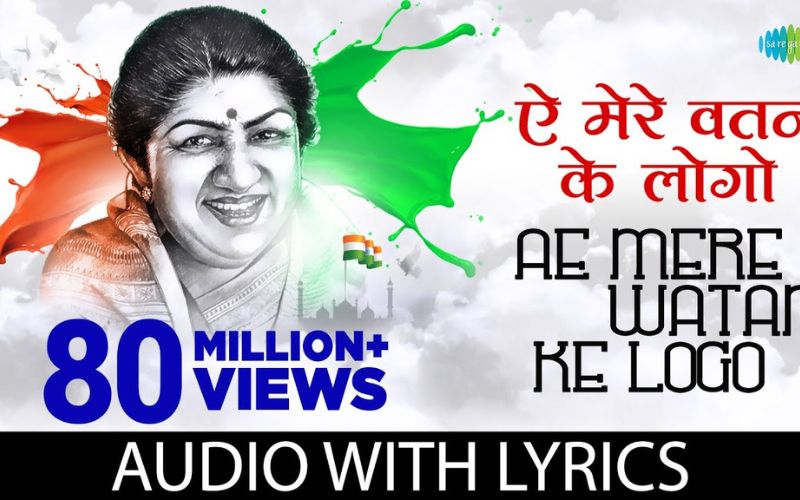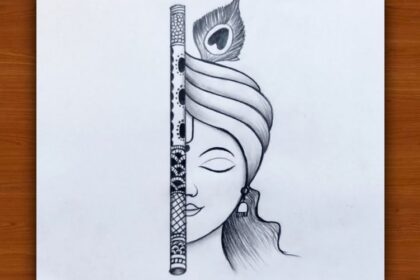“Ae Mere Watan Ke Logo Zara Aankh Me Bharlo Pani” is a patriotic song that has become a timeless classic in the hearts of Indians. The lyrics, written by Kavi Pradeep, capture the profound emotions of love, sacrifice, and unwavering devotion to one’s motherland. This iconic song has transcended generations, serving as a poignant reminder of the sacrifices made by the brave soldiers who laid down their lives for the nation.
The song was first performed on January 27, 1963, at the Ramlila Grounds in New Delhi, with Lata Mangeshkar’s mesmerizing vocals. The performance was a tribute to the Indian soldiers who had fallen during the Sino-Indian War of 1962. The emotional impact of the song was so overwhelming that it is said to have brought tears to the eyes of the then-Prime Minister, Jawaharlal Nehru.
Historical significance of the lyrics
The lyrics of “Ae Mere Watan Ke Logo Zara Aankh Me Bharlo Pani” were written against the backdrop of the Sino-Indian War, a conflict that tested the resilience and patriotism of the Indian people. The song’s powerful words reflect the nation’s collective grief, honoring the sacrifices made by the soldiers who fought to defend their homeland.
The lyrics poignantly capture the pain and sorrow of the nation, expressing the anguish of a people who have lost their loved ones in the line of duty. The lines “Ae mere watan ke logon, zara aankh me bharlo pani” (Oh, people of my country, shed a tear in your eyes) and “Jinhone diya hai apna bal, jinhone diya hai apna jeevan” (Those who gave their strength, those who gave their lives) are particularly powerful, evoking a deep sense of reverence and gratitude for the brave souls who made the ultimate sacrifice.
Analysis of the lyrics
The lyrics of “Ae Mere Watan Ke Logo Zara Aankh Me Bharlo Pani” are a masterful blend of poetic imagery and emotional depth. The song’s structure is built around a series of rhetorical questions and declarations, each one designed to elicit a profound response from the listener.
The opening lines, “Ae mere watan ke logon, zara aankh me bharlo pani” (Oh, people of my country, shed a tear in your eyes), set the tone for the entire song. The use of the word “zara” (a little) conveys a sense of restraint, as if the poet is asking the audience to hold back their tears, for the emotions that are about to be expressed are too powerful to be fully contained.
The subsequent lines delve deeper into the sacrifices made by the soldiers, using vivid imagery to paint a picture of their bravery and selflessness. The line “Jinhone diya hai apna bal, jinhone diya hai apna jeevan” (Those who gave their strength, those who gave their lives) is particularly poignant, as it captures the essence of the soldiers’ unwavering commitment to their country.
The song’s structure also features a series of rhetorical questions, such as “Kya khoon-e-shaheed pe tum aansu nahin bahate?” (Don’t you shed tears on the blood of the martyrs?) and “Kya dil mein nahin aata unki yaad?” (Don’t you remember them in your heart?). These questions serve to engage the audience, inviting them to reflect on the sacrifices made by the soldiers and the importance of honoring their memory.
Emotional impact of the song
The emotional impact of “Ae Mere Watan Ke Logo Zara Aankh Me Bharlo Pani” is undeniable. The song’s ability to evoke a profound sense of patriotism and reverence for the nation’s heroes is a testament to the power of its lyrics and the emotive delivery of Lata Mangeshkar’s rendition.
The song’s ability to move its audience to tears is a testament to the depth of the emotions it conveys. The lines “Jinhone diya hai apna bal, jinhone diya hai apna jeevan” (Those who gave their strength, those who gave their lives) are particularly poignant, evoking a sense of profound gratitude and respect for the soldiers who made the ultimate sacrifice.
The song’s ability to transcend time and space is also remarkable. Even decades after its initial performance, “Ae Mere Watan Ke Logo Zara Aankh Me Bharlo Pani” continues to resonate with audiences, serving as a timeless tribute to the nation’s heroes and a reminder of the sacrifices that have been made to preserve the country’s freedom and independence.
Cultural relevance of the song
“Ae Mere Watan Ke Logo Zara Aankh Me Bharlo Pani” has become an integral part of India’s cultural fabric, transcending its origins as a tribute to the soldiers of the Sino-Indian War. The song has become a symbol of the nation’s enduring spirit, a rallying cry for patriotism, and a testament to the resilience and courage of the Indian people.
The song’s cultural relevance is further underscored by its widespread popularity and the numerous tribute performances and renditions that have been created over the years. From school assemblies to national events, “Ae Mere Watan Ke Logo Zara Aankh Me Bharlo Pani” has become a staple of Indian cultural celebrations, serving as a unifying force that brings the nation together in a shared expression of patriotism and reverence.
The song’s enduring legacy is also reflected in its inclusion in various cultural and educational curricula, where it is studied and analyzed as a significant work of Indian literature and music. This recognition further cements the song’s place as a cornerstone of India’s cultural heritage, ensuring that its message of sacrifice and patriotism will continue to inspire generations to come.
Tribute performances and renditions
Since its initial performance in 1963, “Ae Mere Watan Ke Logo Zara Aankh Me Bharlo Pani” has been the subject of numerous tribute performances and renditions, each one serving to honor the song’s enduring legacy and the sacrifices of the nation’s heroes.
One of the most notable tribute performances was the one given by Lata Mangeshkar herself, who returned to the Ramlila Grounds in 2013 to mark the 50th anniversary of the song’s debut. Her emotional rendition, which brought tears to the eyes of the audience, was a powerful reminder of the song’s enduring ability to evoke a profound sense of patriotism and reverence.
Over the years, the song has also been covered by a wide range of artists, from classical vocalists to Bollywood playback singers. Each interpretation has brought a unique perspective to the song, adding to its rich tapestry of cultural significance.
In addition to individual performances, “Ae Mere Watan Ke Logo Zara Aankh Me Bharlo Pani” has also been featured in various national events and celebrations, serving as a unifying force that brings the nation together in a shared expression of patriotism and gratitude.
Understanding the patriotic message
At the heart of “Ae Mere Watan Ke Logo Zara Aankh Me Bharlo Pani” lies a powerful message of patriotism and reverence for the nation’s heroes. The song’s lyrics, written by the renowned poet Kavi Pradeep, are a poignant tribute to the sacrifices made by the soldiers who fought to defend their homeland.
The song’s opening lines, “Ae mere watan ke logon, zara aankh me bharlo pani” (Oh, people of my country, shed a tear in your eyes), set the tone for the entire work, inviting the audience to reflect on the profound emotions and sacrifices that have shaped the nation’s history.
Throughout the song, the lyrics delve deeper into the bravery and selflessness of the soldiers, using vivid imagery to paint a picture of their unwavering commitment to their country. The lines “Jinhone diya hai apna bal, jinhone diya hai apna jeevan” (Those who gave their strength, those who gave their lives) are particularly powerful, evoking a sense of profound gratitude and respect for the soldiers who made the ultimate sacrifice.
The song’s ability to transcend time and space is a testament to the enduring power of its patriotic message. Even decades after its initial performance, “Ae Mere Watan Ke Logo Zara Aankh Me Bharlo Pani” continues to resonate with audiences, serving as a timeless tribute to the nation’s heroes and a reminder of the sacrifices that have been made to preserve the country’s freedom and independence.
Legacy of the song
The legacy of “Ae Mere Watan Ke Logo Zara Aankh Me Bharlo Pani” extends far beyond its initial performance in 1963. The song has become a cultural touchstone, a symbol of the nation’s enduring spirit, and a testament to the sacrifices made by its heroes.
Over the years, the song has been the subject of numerous tribute performances and renditions, each one serving to honor its enduring legacy and the sacrifices of the nation’s heroes. From Lata Mangeshkar’s emotional return to the Ramlila Grounds in 2013 to the countless cover versions by artists across genres, “Ae Mere Watan Ke Logo Zara Aankh Me Bharlo Pani” has become a staple of Indian cultural celebrations, serving as a unifying force that brings the nation together in a shared expression of patriotism and reverence.
The song’s cultural relevance is further underscored by its inclusion in various educational and cultural curricula, where it is studied and analyzed as a significant work of Indian literature and music. This recognition cements the song’s place as a cornerstone of India’s cultural heritage, ensuring that its message of sacrifice and patriotism will continue to inspire generations to come.
Conclusion
“Ae Mere Watan Ke Logo Zara Aankh Me Bharlo Pani” is a timeless classic that has become an integral part of India’s cultural fabric. The song’s powerful lyrics, written by the renowned poet Kavi Pradeep, serve as a poignant tribute to the sacrifices made by the nation’s heroes, evoking a profound sense of patriotism and reverence.
The song’s emotional impact is undeniable, with its ability to move audiences to tears a testament to the depth of the emotions it conveys. The lines “Jinhone diya hai apna bal, jinhone diya hai apna jeevan” (Those who gave their strength, those who gave their lives) are particularly poignant, capturing the essence of the soldiers’ unwavering commitment to their country.
The song’s cultural relevance is further underscored by its widespread popularity and the numerous tribute performances and renditions that have been created over the years. From school assemblies to national events, “Ae Mere Watan Ke Logo Zara Aankh Me Bharlo Pani” has become a staple of Indian cultural celebrations, serving as a unifying force that brings the nation together in a shared expression of patriotism and reverence.
As the nation continues to honor the sacrifices of its heroes, the legacy of “Ae Mere Watan Ke Logo Zara Aankh Me Bharlo Pani” will endure, serving as a timeless reminder of the power of patriotism and the enduring spirit of the Indian people.
To learn more about the rich cultural heritage and patriotic songs of India, be sure to check out our other blog posts on similar topics. We invite you to explore the stories and traditions that have shaped the nation’s identity and inspired generations of Indians.





